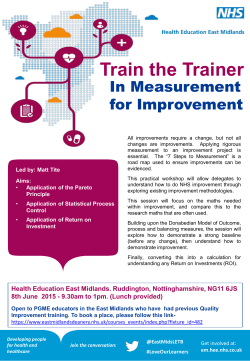
Budget setting paper - Health Education East of England
HEEoE/14/15 Health Education East of England Board Meeting 25th March 2015 / for consideration and assurance Budget Setting for 2015-16 Report of Karen Rutter, Head of Finance, Midlands and East ___________________________________________________________________ 1 Background 1.1 HEE has three components to its income which are: • Programme allocation • Administrative allocation • Other income The first two above form part of the allocation received from the Department of Health (DH) and the third is oncome from other sources. 1.2 The programme allocation is delegated to LETBs following the detailed financial planning undertaken to ensure that the budgets can support the published Workforce Plan. 1.3 The HEE administrative allocation received has been reduced from the level of the previous year and follows a reduction in 2014-15. These reductions and a further expected reduction in 2016-17 are consistent with the assumptions made in HEEs ‘Beyond Transition’ programme of cost reductions. 1.4 Income from other sources is included for completeness. Income relating to NIHR and the Leadership Academy is classed under other income as it does not relate to HEE main programmes. For these areas it should be noted that the income and expenditure nets off to zero. Discussions are ongoing regarding the level of NIHR funding in 2015-16. For the Leadership Academy, there is a risk that funding is reduced significantly which may lead to pressures in LETBs who host local delivery. Developing people for health and healthcare www.eoe.hee.nhs.uk msc.eoeletb@nhs.net @eoeLETB 2. Current Position Expenditure plans are set out below: 2.1 HEEoE produced an investment plan, which signalled commissioning intentions for 15-16, and a financial model which included detailed spending plans for all of HEEoEs activities. The final versions have been completed in the last few weeks. The level of detail in the financial model helps to ensure that 15-16 budgets provide for the implementation of the Workforce Plan agreed by the HEE Board in December. The table below illustrates the total 15-16 East of England budget and prior year comparison, with key movement explanations following the table. Table 1: Programme Expenditure (net of contributions to programme and other income) 14-15 budget Future workforce: Postgrad M&D Undergrad M&D Non Medical Other Subtotal Future workforce Workforce development Education support National Activities Total Programme 2.2 £000 153,336 35,873 148,437 15-16 budget Change 337,646 £000 153,601 35,371 150,579 -100 339,451 £000 265 -502 2,142 -100 1,805 18,119 14,597 991 19,673 14,597 991 1,554 0 0 371,353 374,712 3,359 % change 0.2 -1.4 1.4 0.0 8.6 0.0 0.0 Future Workforce budgets include the following. • Funding to NHS Trusts, GP practices and other organisations to meet the additional costs of clinical placements in these organisations and a contribution towards the salary costs of certain trainees. • Funding to higher education institutions for tuition costs and other costs supporting training and education provision. Developing people for health and healthcare www.eoe.hee.nhs.uk msc.eoeletb@nhs.net @eoeLETB • Funding to meet the cost of bursaries recharged by the Business Services Agency for students on eligible courses. Budgets for undergraduate medical assume that the tariff reduction for undergraduate clinical placements fees paid to NHS service providers will be reduced by 1.9%. DH undertook to reduce this tariff as part of the overall HEE allocation settlement, which makes it possible for the workforce plan to be affordable within the slightly reduced allocation. The HEE allocation anticipated a reduction in undergraduate medical and dental costs as reductions in student intake back in 2012 feeds through to reductions in placement activity in their third year. At present it is assumed that reductions apply equally across all HEE areas and the delegated budget to LETBs reflect this assumption. Data is being collected from medical and dental schools and once analysed, may indicate a redistribution of funds between LETBs. These budgets include the impact of the second year of ‘zero uplift’ to the Benchmark Prices paid to HEIs in relation to undergraduate course fees for non-medical courses. However, the part-year effect of the increase in nonmedical commissions in the workforce plan result in increased investment in non-medical future workforce. 2.3 Education Support describes the infrastructure for supporting Programme activities for example recruitment of trainees and managing the quality of education programmes. 2.4 Workforce Development funding is an important resource to support the improvement, and changes to the skill base of the existing NHS Workforce which are essential to the transformational changes needed to deliver the recently published vision for the future published jointly by the statutory bodies with responsibility for the NHS – the Five Year Forward View. In March 2014, the HEE Board agreed a three year redistribution plan to move the historically derived budgets at LETB level to a more even distribution. The £19.7m budget in 15-16 will move to £18.8m in 16-17, the final year of the three year plan. There remains a degree of risk that transformational programmes of work previously funded at a national level will need local investment which will have a financial impact. There is also a risk at this stage in the electoral cycle that a new Government would impose additional requirements on HEE. In view of the risks identified above HEE have agreed that 5% of the locally held Workforce Development budgets be retained by local teams as Developing people for health and healthcare www.eoe.hee.nhs.uk msc.eoeletb@nhs.net @eoeLETB uncommitted to act as a buffer against cost changes. Redeployment or releasing of these budgets is to take place no later than 30 September 2015. The transformational programmes of work under this category of expenditure are subject to more uncertainty with regard to delivery than those activities driven by student numbers and fixed prices. As such, there may be scope in year to re-invest in areas of priority that require an immediate response. Any changes to planned spend will be managed by the LETB Director and reported to this Board. 2.5 Nationally hosted activities are those areas that East of England take the lead on behalf of the whole of HEE. There is no change to the level of funding in 15-16 relating to some training post funding managed on behalf of other LETBs. 2.6 Admin Expenditure: HEEs restructuring Programme, Beyond Transition, reduced admin costs to provide for the anticipated allocation reductions over the three years 2013/14 to 2016/17 and to cover the impact of inflation on our costs during that period. Admin budgets in Midlands and East have been determined at £13.6m and will be the responsibility of the Geographic Director. This total includes those geographically located finance staff who report to the Head of Finance (Geography). East of England running costs form part of that overall budget but the responsibility for management of this budget is no longer at LETB level. 3. Recommendation 3.1 The Board is asked to note: • • the delegated programme funding for 2015-16. the admin control totals under the responsibility of the Geographical Director. Developing people for health and healthcare www.eoe.hee.nhs.uk msc.eoeletb@nhs.net @eoeLETB 3.2 The Board is asked to approve the proposed budget for 2015-16, in particular: • Holding back 5% of the Workforce Development budget against risks identified in the report Karen Rutter Head of Finance, Midlands and East Developing people for health and healthcare www.eoe.hee.nhs.uk msc.eoeletb@nhs.net @eoeLETB
© Copyright 2025





















